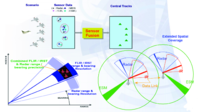
Photo from wikipedia
Dempster–Shafer evidence theory is an effective way to solve multi-sensor data fusion problems. After developing many improved combination rules, Dempster–Shafer evidence theory can also yield excellent results when fusing highly… Click to show full abstract
Dempster–Shafer evidence theory is an effective way to solve multi-sensor data fusion problems. After developing many improved combination rules, Dempster–Shafer evidence theory can also yield excellent results when fusing highly conflicting evidence. However, these approaches still have deficiencies if the conflicting evidence is due to sensor malfunction. This work presents a combination method by integrating information interaction graph and Dempster–Shafer evidence theory; thus, the multiple evidence fusion process is expressed as a network. In particular, the credibility of each piece of evidence is obtained by measuring the distance between the evidence first. After that, the credibility of the evidence is evaluated, keeping the unreliable evidence out of the information interaction network. With the fusion of connected evidence, the accuracy of the fusion result is improved. Finally, application results show that the presented method is effective.
Journal Title: Entropy
Year Published: 2022
Link to full text (if available)
Share on Social Media: Sign Up to like & get
recommendations!